-
Paper Information
- Paper Submission
-
Journal Information
- About This Journal
- Editorial Board
- Current Issue
- Archive
- Author Guidelines
- Contact Us
American Journal of Intelligent Systems
p-ISSN: 2165-8978 e-ISSN: 2165-8994
2017; 7(1): 19-30
doi:10.5923/j.ajis.20170701.02

Simulation and Performance Comparison of Ant Colony Optimization (ACO) Routing Protocol with AODV, DSDV, DSR Routing Protocols of Wireless Sensor Networks using NS-2 Simulator
Anand Nayyar1, Rajeshwar Singh2
1Ph.D (Computer Science) Research Scholar, Desh Bhagat University, Mandi Gobindgarh, India
2Director, Doaba Group of Colleges, Nawanshahr, Rahon, India
Correspondence to: Anand Nayyar, Ph.D (Computer Science) Research Scholar, Desh Bhagat University, Mandi Gobindgarh, India.
| Email: |  |
Copyright © 2017 Scientific & Academic Publishing. All Rights Reserved.
This work is licensed under the Creative Commons Attribution International License (CC BY).
http://creativecommons.org/licenses/by/4.0/

Wireless Sensor Networks, in the last few decades, have witnessed significant amount of improvement in research across various areas like Routing, Security, Localization, Deployment and above all Energy Efficiency. Nowadays, the main central point of attraction is the concept of Swarm Intelligence based techniques integration in WSN. Swarm Intelligence based Computational Swarm Intelligence Techniques have improvised WSN in terms of efficiency, performance, robustness and scalability. The main objective of this research paper is to simulate and compare the performance of various existing routing protocols like AODV, DSDV and DSR routing protocols with ACO Based Routing Protocol in terms of End to End Delay, Packet Delivery Rate, Routing Overhead, Throughput and Energy Efficiency. Simulation based results and data analysis shows that overall ACO is 150% more efficient in terms of overall performance as compared to other existing routing protocols for Wireless Sensor Networks.
Keywords: Wireless Sensor Networks, Swarm Intelligence, Ant Colony Optimization (ACO), AODV, DSDV, DSR, Routing, NS-2, Simulation, Performance Comparison
Cite this paper: Anand Nayyar, Rajeshwar Singh, Simulation and Performance Comparison of Ant Colony Optimization (ACO) Routing Protocol with AODV, DSDV, DSR Routing Protocols of Wireless Sensor Networks using NS-2 Simulator, American Journal of Intelligent Systems, Vol. 7 No. 1, 2017, pp. 19-30. doi: 10.5923/j.ajis.20170701.02.
Article Outline
1. Introduction
- In 21st Century, Wireless Sensor Networks [1] has gained huge amount of attention of researchers across the nook and corner in this world with regard to tons of theoretical, practical and implementation challenges. The research progress in Wireless Sensor Networks has explored diverse novel applications enabled by large-scale networks comprising of thousands of sensor nodes capable of sensing environmental information, processing it in efficient manner and transmitting the information back to base locations for further analysis. Wireless Sensor Networks comprise of large number of low-cost, low power and multi-functional capable wireless sensor nodes [2, 3] for sensing different information’s, equipped with wireless communication transmission mediums and computational capabilities. In sensor nodes, different types of sensors in form of mechanical, biological, chemical, optical can be attached to acquire real-time data from environment and transmit it back after processing. The sensor nodes forming Wireless Sensor Networks [4, 5] have limitation in terms of low memory, less processing speeds. A radio is integrated on nodes to transmit the information back to sink node. The nodes are powered using battery to act as main power source. As the batteries are the only and primary power source, it becomes difficult to replace and charge the batteries once nodes are deployed which remains the foremost challenge in front of researchers to enhance the Energy Efficiency of sensor nodes. The characteristics of Wireless Sensor Network [1, 6, 3] are Deployment of sensor nodes; Less power; less computation capability; Limited memory; Unreliability. Therefore, the characteristics open wide range of challenges for the development and real-time implementations of wireless sensor network in the world.Sensor nodes once deployed in the real world are grouped into clusters, and each cluster has a node named as “Cluster Head”. All the nodes in the cluster forward their sensed data to the cluster head and it is the duty of Cluster Head to route the information back to Sink Node (termed as “Base Station”) via multi-hop wireless communication as shown in Fig. 1.
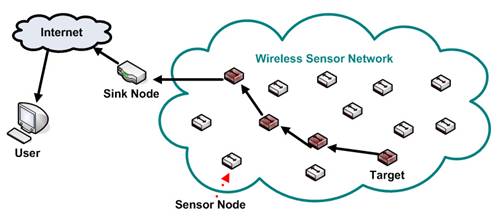 | Figure 1. Wireless Sensor Network |
2. Challenges and Shortcomings in Wireless Sensor Networks
- Wireless Sensor Networks, in current scenario, provides tremendous solutions for design and development of many real-time sensor applications. Sensors, currently available in the market are of two types: Generic (also known as “Multi-Purpose”) and Gateway (also known as “Bridge Nodes”) to take data from environment depending on scenario deployment. Generic Sensor Nodes main task is to capture data from environment and is equipped with various devices that can measure various attributes like Temperature, Humidity, Acceleration, Acoustics etc. Gateway Nodes perform the duty of gathering the data from generic nodes and transmit back to sink node/base station. Gateway nodes as compared to generic nodes are more powerful in terms of processing, energy, wireless transmission range etc. To enable WSN application using sensor nodes, the design of WSN’s should be improvised to large extent and routing protocols should be efficient enough to address network constraints in terms of Energy, Processing, Security, Memory etc. In order to solve all these constraints, Swarm Intelligence- Computational Intelligent techniques comes into limelight. A brief overview of Primary WSN challenges to be resolved by Swarm Intelligence- CI Based Techniques are enlisted as follows: [7-11]• Design and Deployment: Sensor Nodes are to be deployed in wide range of applications from simple human body characteristics monitoring to Large Forest Fire detection activities. Deployment can be predetermined or sometimes undetermined. Sensor Nodes should be designed and deployed in such a manner that accurate monitoring can be possible without any failure or field hindrance. • Localization: Node localization is designed as process of creating location awareness in all sensor nodes forming the network. Location information is used to detect and record activities, and even used to route packets using Geographical-aware routing algorithms. Localization methods makes use of time-arrival of signals from multiple base-stations for efficient routing.• Energy Aware Routing: In simple words, routing is defined as path of transferring the message from source to destination. Routing in WSN is classified in two categories: Proactive and Reactive. In proactive routing, routing tables are generated and stored without considering any routes. In reactive routing, routes are computed. In tough environmental conditions, routing tables can occupy tons of memory so Hybrid Routing (Proactive+Reactive) [12, 13] based routing techniques are proposed for transmission.• Efficient Packet Scheduling: Energy is the prime constraint for sensor nodes. In order to overcome this challenge, sensor nodes remain in sleep state most of the time, and only activates themselves when transmission path requires them for routing. A Stringent and Efficient scheduling is required to maintain node wakeup, sense and transmit in order to maintain energy in nodes.• Security: As sensor nodes used Wireless Links for transmission, so wireless links are always vulnerable to varied attacks like eavesdropping, denial of service, attenuation, packet hijacking etc. Security becomes really challenging when nodes are deployed in Dynamic Topology. Security is one of the serious challenges and issue to be resolved to keep the data secure and accurate. So, varied SI based defenses are being proposed to make the WSN network highly secure and protective against attacks from outside world.• Data Aggregation: As sensor nodes can generate significant amount of redundant data, and same data can be produced by multiple nodes operating in the network. Various Data Aggregation techniques are deployed and proposed to maintain energy efficiency and data optimization in routing protocols.• Quality of Service (QoS): QoS refers to assurance guaranteed by network to provide quality in terms of Fairness, Delay, Jitter, Bandwidth, Packet Loss etc. [14] In order to ensure that every parameter is giving the maximum fair output, diverse QoS mechanisms are being proposed as per applications to keep WSN network quality based real-time data acquiring network.
3. Swarm Intelligence
- Swarm Intelligence [15-20], another novel branch of Artificial Intelligence, has attracted several researchers to apply SI based optimization techniques in solving varied problems of Robotics, Networking, Wireless Communications, Drones, Electronics, Information Theory and other diverse areas.Swarm Intelligence concept was first introduced by Gerardo Beni and Jing Wang [24] in 1989 with relation to cellular robotic systems. In general terms, Swarm Intelligence [17-19, 21] is modelling of collective behaviors of simple agents interacting locally among themselves, and their environment, which leads to the evolution of a coherent functional global pattern. These models are inspired by social behavior of insects and other animals. Talking in terms of computation, Swarm Intelligence models are computing algorithm models used for undertaking and solving complex distributed optimization problems. The basic principle of Swarm Intelligence primarily focusses on “Probabilistic-based Search Algorithms” [22, 23, 25, 26]. In Swam Intelligence, the most significant concept is “Swarm”. Swarm is used to refer any restrained collection of interacting agents or individuals. Communication among these swarms in distributed manner without any requirement of centralized control mechanism makes these models highly realistic and robust to be implemented in diverse applications. The concept of Swarm Intelligence was started by two main Algorithms: Ant Colony Optimization (ACO) being developed by Dorigo and Stutzle in 2004 and Particle Swarm Optimization (PSO) being developed by Kennedy and Eberhart in 2001. With time, various other algorithms have come up and make the Swarm Intelligence more rich and implementable in different applications like Fish Swarm, Monkey Swarm, Glowworms, Bee Colony, Artificial Immune System, Firefly Algorithm and many more. Swarm Intelligence primarily works on two founding principles:1. Self Organization2. StigmergySelf-Organization: The concept of Self Organization was defined by Bonabeau et al [27, 28] in 1999 as “Self Organization is a set of Dynamic Mechanisms whereby structures appear at the global level of a system from interactions of its lower-level components”. Self organization lays the foundation of three important characteristics: Structure, Multi-Stability and State Transition. Structure: It is founded from a homogeneous start-up state. E.g. Ant Foraging trails.Multi-Stability: Co-existence of many stable states. E.g. Behavior of ants to search for food random in field.State Transitions: Change of System Behavior. Example: Location of new food source after finishing the entire food transmit from source to nest. Stigmergy: The word “Stigmergy” is mix of two words: Stigma= Work and Ergon=Work which means Simulation by work. It is based on the principle that the main area to operate for swarms in Environment and work is not dependent on specific agents. It can be summarized as, “Coordination, Cooperation and Regulation of tasks doesn’t depend on workers directly, but on construction themselves”. The worker is properly guided rather than directed to perform the work. It is also a special form of stimulation called Stigmergy. Stigmergy can be of following types:• Sign-Based Stigmergy: Ant Foraging Behavior; Ants Trail Following from nest to food source and vice versa.• Sematactonics: Building of nests by Termites.• Quantitative: Ants Foraging Behavior• Qualitative: Nest building by Wasps.For modelling the behaviors of Swarms, Millonas [29] laid the following 4 Principles as follows:1. Proximity Principle of Swarm: Swarms should be highly capable to perform simple computations with respect to the environment existing around them in terms of time and space. E.g. Search for living place and building nest in coordination.2. Quality Principle of Swarm: Swarm should be highly respondent to environmental quality factors like food, safety and other stuff.3. Diverse Response Principle of Swam: The swarm should not allocate all of its resources along excessively narrow channels and it should distribute resources into many nodes.4. Stability and Adaptability Principle of Swarm: Swarms are expected to adapt environmental fluctuations without rapidly changing modes since mode changing involves tremendous amounts of energy.
4. Ant Colony Optimization
- A. Introduction to Ant Colony OptimizationAnt Colony Optimization (ACO) [30-37] was discovered and introduced by M. Dorigo and colleagues as a Nature-Inspired meta-heuristic for providing optimal solutions to hard combinatorial optimization (CO) problems. A Meta heuristic is regarded as set of algorithms that can be used to elaborate heuristic method applicable to wide range of problems. It is regarded as general purpose framework to different optimization problems with few modifications. “Marco Dorigo” in his Ph.D Thesis “Optimization, Learning and Natural Algorithms”, in which he elaborated the way to solve problems using behavior being used by real ants, presents the first Algorithm defining the framework in 1991. Real Ants are highly sophisticated and intelligent swarms to find the shortest path from food source to nest by depositing pheromone on the ground and laying the trails so that other ants can follow. The most important component of ACO Algorithms is the combination of a priori information regarding the structure with a posteriori information about the structure of previously obtained optimal solutions. In order to determine the shortest path, a moving ant lay the pheromone which acts as base for other ants to follow and deciding the high probability to follow it. As a result, it leads to the emergence of collective behavior and forms a positive feedback loop system through which other ants can follow the path and makes the pheromone more stable and best path for transferring the food back to nest.B. Combinatorial Optimization Problem- DefinitionThe first step for the application of ACO to a combinatorial optimization problem (COP) consists in defining a model of the COP as a triplet (S,Ω,f), where:• S is a search space defined over a finite set of discrete decision variables;• Ω is a set of constraints among the variables; and• f:S→R+0 is an objective function to be minimized (as maximizing over f is the same as minimizing over –f, |every COP can be described as a minimization problem).The search space S| is defined as follows. A set of discrete variables Xi, i=1,…,n, with values vji∈Di={v1i,…,v|Di|i}, is given. Elements of S are full assignments, that is, assignments in which each variable Xi has a value vji assigned from its domain Di. The set of feasible solutions SΩ is given by the elements of S that satisfy all the constraints in the set Ω.A solution s∗∈SΩ is called a global optimum if and only iff(s∗)≤f(s) ∀s∈SΩ.|The set of all globally optimal solutions is denoted by S∗Ω⊆SΩ. Solving a COP requires finding at least one s∗∈S* Ω.
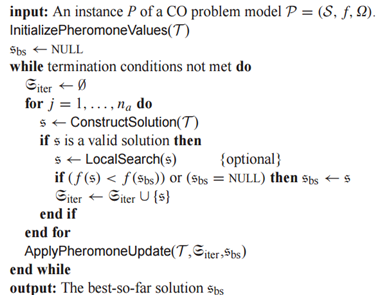 Algorithm for Combinatorial Optimization ProblemC. ACO for Travelling Salesman Problem (TSP)Ant Algorithms are developed on population based approach are applied to combat various NP-hard combinatorial optimization problems. It was the first ACO algorithm, known as “ANT System” [32, 34, 35]. Ant System was applied to Travelling salesman problem (TSP). The TSP comprise of group of cities connected to each other and distance between them is also known. The objective is to attain the shortest path which facilitates to visit every city at least once. In order words, to calculate Hamiltonian type coverage of minimal distance between cities on a fully connected graph.TSP plays vital role in ACO algorithms because of the following reasons:1. Easily applied to ACO algorithms as ants have same kind of behavior to determine the efficient path from nest to source by laying pheromone trails randomly and then choosing the best path for other ants to follow.2. Regarded as NP-hard problem.3. It is a standard testing platform for new algorithms to be checked out and a good performance on TSP is taken into consideration as proof for their correctness and efficiency.4. TSP being the first combinatorial problem, that was solved by ant algorithms.Algorithm- Ant Colony Optimization Applied to Travelling Salesman Problem
Algorithm for Combinatorial Optimization ProblemC. ACO for Travelling Salesman Problem (TSP)Ant Algorithms are developed on population based approach are applied to combat various NP-hard combinatorial optimization problems. It was the first ACO algorithm, known as “ANT System” [32, 34, 35]. Ant System was applied to Travelling salesman problem (TSP). The TSP comprise of group of cities connected to each other and distance between them is also known. The objective is to attain the shortest path which facilitates to visit every city at least once. In order words, to calculate Hamiltonian type coverage of minimal distance between cities on a fully connected graph.TSP plays vital role in ACO algorithms because of the following reasons:1. Easily applied to ACO algorithms as ants have same kind of behavior to determine the efficient path from nest to source by laying pheromone trails randomly and then choosing the best path for other ants to follow.2. Regarded as NP-hard problem.3. It is a standard testing platform for new algorithms to be checked out and a good performance on TSP is taken into consideration as proof for their correctness and efficiency.4. TSP being the first combinatorial problem, that was solved by ant algorithms.Algorithm- Ant Colony Optimization Applied to Travelling Salesman Problem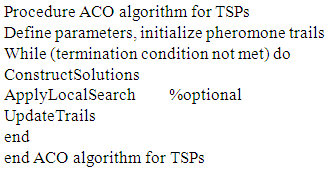 D. Ant Colony Optimization-DefinitionAnt Colony Optimization technique is based on ants i.e. how ant colonies find the efficient path between nest and food source. In search of food, ants roam randomly in the environment. On location of the food source, ant’s first return back to their nest by laying a trail of chemical substance called “Pheromone” in their path. Pheromone lays the foundation for communication medium for other ants to follow the way and go to the food source. When other ants follow the path, the quantity of pheromone increases on that particular path. The rich the quantity of pheromone along the path, the more likely is that other ants will detect and follow the path. In other words, ants follow that path which is marked by strongest pheromone quantity. As pheromone evaporates over time, which in turn reduces its attractive strength. The longer the time taken by ant to travel the path from food source to nest, the quicker the pheromone will evaporate. So, the path should be shorter so that the active strength of pheromone is maintained and ants can easily transfer the food from source to nest. So, in turn of this policy the shortest path will naturally emerge.Algorithm: Ant Colony OptimizationInitialize ParametersInitialize pheromone trailsCreate antsWhile stopping criteria is not reached, doLet all ants construct their solutionUpdate pheromone trailsAllow Daemon ActionsEnd whileE. Suitablilty of Ant Colony Optimization Routing Algorithm towards Wireless Sensor NetworksAnt Colony Optimization Routing Algorithm mentioned above is highly suitable and performs well in Wireless Sensor Networks because of the following reasons:1) Provide traffic adaptive and multipath routing. 2) Rely on both passive and active information monitoring and gathering. 3) Making use of stochastic components. 4) Don’t allow local estimates to have global impact.5) Setup paths in a less selfish way than in pure shortest path schemes favoring load balancing. 6) Showing limited sensitivity to parameter settingsF. Basic Ant Routing Algorithm [37]Let
D. Ant Colony Optimization-DefinitionAnt Colony Optimization technique is based on ants i.e. how ant colonies find the efficient path between nest and food source. In search of food, ants roam randomly in the environment. On location of the food source, ant’s first return back to their nest by laying a trail of chemical substance called “Pheromone” in their path. Pheromone lays the foundation for communication medium for other ants to follow the way and go to the food source. When other ants follow the path, the quantity of pheromone increases on that particular path. The rich the quantity of pheromone along the path, the more likely is that other ants will detect and follow the path. In other words, ants follow that path which is marked by strongest pheromone quantity. As pheromone evaporates over time, which in turn reduces its attractive strength. The longer the time taken by ant to travel the path from food source to nest, the quicker the pheromone will evaporate. So, the path should be shorter so that the active strength of pheromone is maintained and ants can easily transfer the food from source to nest. So, in turn of this policy the shortest path will naturally emerge.Algorithm: Ant Colony OptimizationInitialize ParametersInitialize pheromone trailsCreate antsWhile stopping criteria is not reached, doLet all ants construct their solutionUpdate pheromone trailsAllow Daemon ActionsEnd whileE. Suitablilty of Ant Colony Optimization Routing Algorithm towards Wireless Sensor NetworksAnt Colony Optimization Routing Algorithm mentioned above is highly suitable and performs well in Wireless Sensor Networks because of the following reasons:1) Provide traffic adaptive and multipath routing. 2) Rely on both passive and active information monitoring and gathering. 3) Making use of stochastic components. 4) Don’t allow local estimates to have global impact.5) Setup paths in a less selfish way than in pure shortest path schemes favoring load balancing. 6) Showing limited sensitivity to parameter settingsF. Basic Ant Routing Algorithm [37]Let  be a connected graph with
be a connected graph with  nodes. The simple ant colony algorithm can be used to find the shortest path between a source node
nodes. The simple ant colony algorithm can be used to find the shortest path between a source node and a destination node
and a destination node  on the graph G. The path length is given by the number of nodes on the path.Each edge
on the graph G. The path length is given by the number of nodes on the path.Each edge  of the graph connecting the nodes
of the graph connecting the nodes  and
and  has a variable
has a variable  (artificial pheromone), which is modified by the ants when they visit the node. The pheromone concentration
(artificial pheromone), which is modified by the ants when they visit the node. The pheromone concentration  is an indication of the usage of this edge.
is an indication of the usage of this edge. | (1) |
 uses pheromone
uses pheromone  of node
of node  to compute the probability of node
to compute the probability of node  as next hop.
as next hop.  is the set of one-step neighbors of node
is the set of one-step neighbors of node  .
. | (2) |
 of a node
of a node  fulfill the constraint:
fulfill the constraint: | (3) |
 of pheromone of the edge
of pheromone of the edge  when moving from node
when moving from node  to node
to node  as follows:
as follows: | (4) |
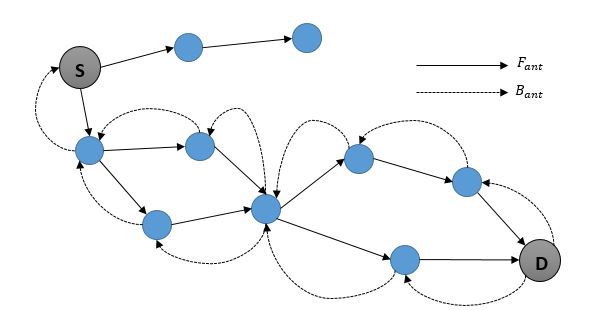 | Figure 2. Route Discovery Phase in Ant Colony Routing |
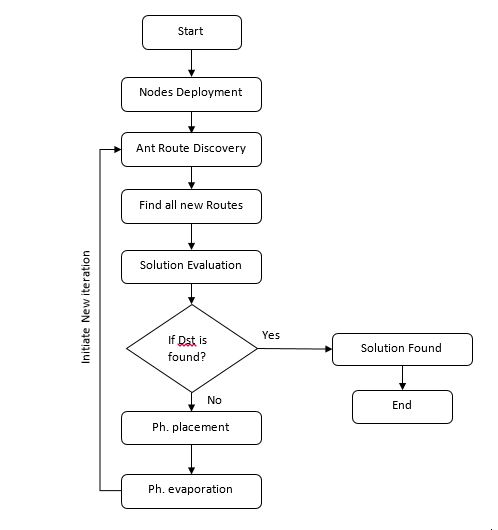 | Figure 3. Flowchart showing the Working of Basic Ant Colony Routing Protocol |
5. Simulation and Results
- In this section of research paper, the Simulation Parameters, Simulation Screenshots and Comparison of ACO with other Routing Protocols is being demonstrated.A. Simulation ParametersThe Implementation of Basic Ant Colony Routing Algorithm is done on NS-2 Simulator 2.35 [41-44]. The following Table No: 1 highlights simulation parameters used for Simulating and Comparing ACO based Routing Protocol for Wireless Sensor Networks with other Routing Protocols i.e. AODV, DSDV and DSR.
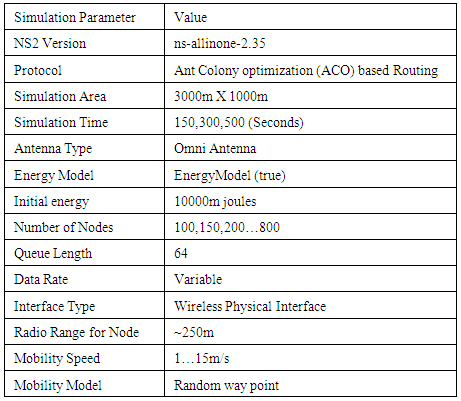 B. Simulation Screenshots and Live Working of Ant Colony Optimization Routing Algorithm in Wireless Sensor NetworksThis section of research paper highlights the Live Screenshots demonstrating the working of ACO based routing protocols for Wireless Sensor networks and compared with other routing protocols i.e. AODV, DSDV and DSR using NS-2 Simulator.In the Fig. 4 100 nodes are deployed in 3000m x 1000m forming Wireless Sensor networks and proper positioning of nodes is being done for simulating the routing of packets using ACO based routing protocol for determining the performance.
B. Simulation Screenshots and Live Working of Ant Colony Optimization Routing Algorithm in Wireless Sensor NetworksThis section of research paper highlights the Live Screenshots demonstrating the working of ACO based routing protocols for Wireless Sensor networks and compared with other routing protocols i.e. AODV, DSDV and DSR using NS-2 Simulator.In the Fig. 4 100 nodes are deployed in 3000m x 1000m forming Wireless Sensor networks and proper positioning of nodes is being done for simulating the routing of packets using ACO based routing protocol for determining the performance.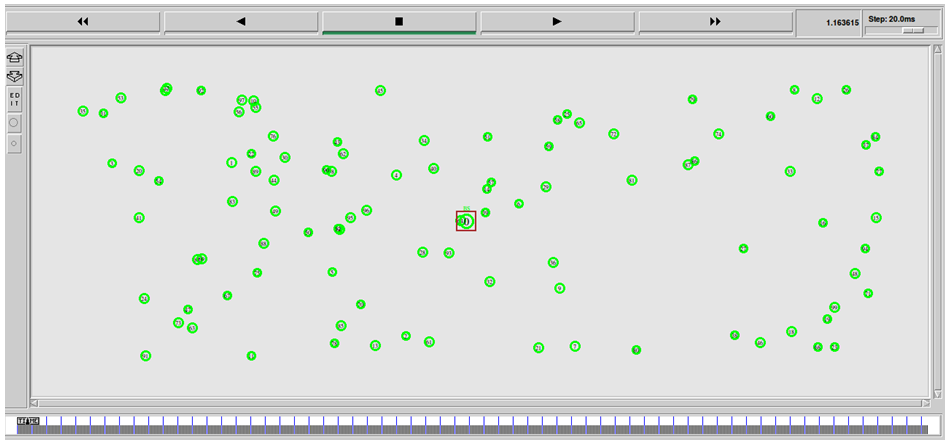 | Figure 4. Deployment of 100 nodes creating WSN |
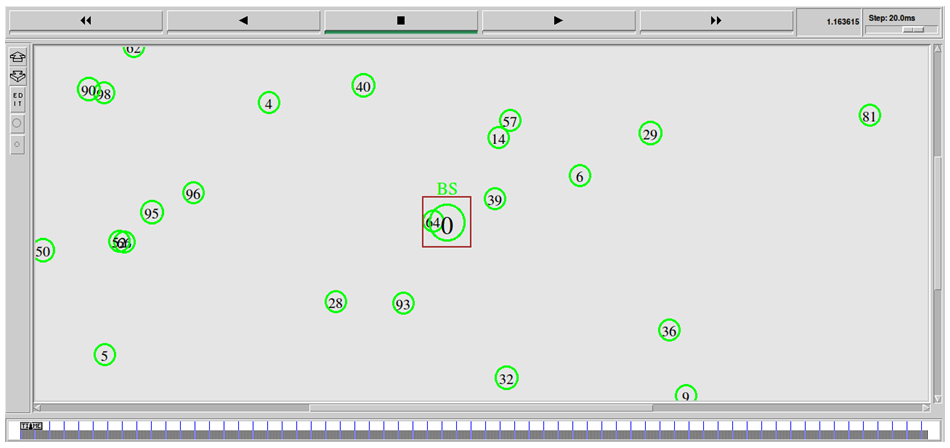 | Figure 5. Base Station Location |
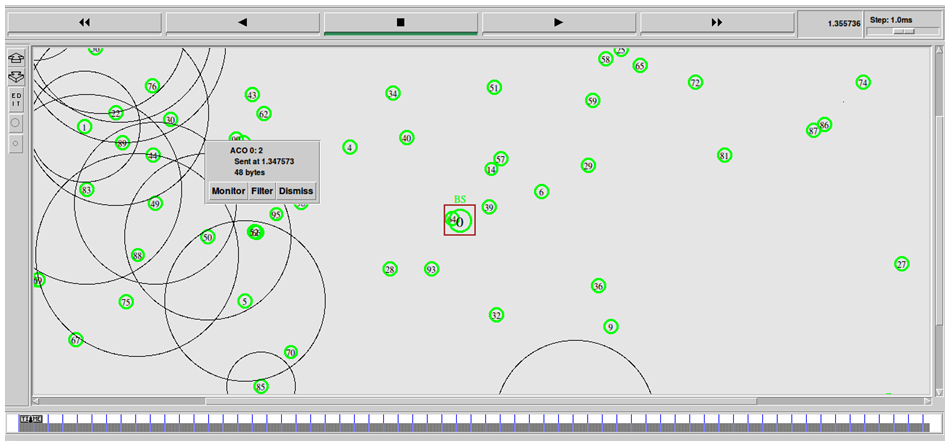 | Figure 6. Route Discovery |
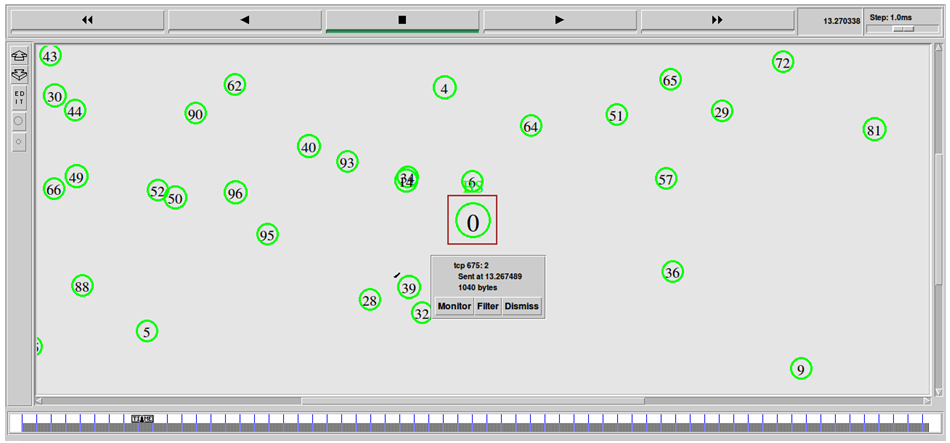 | Figure 7. Transmission of TCP Packet |
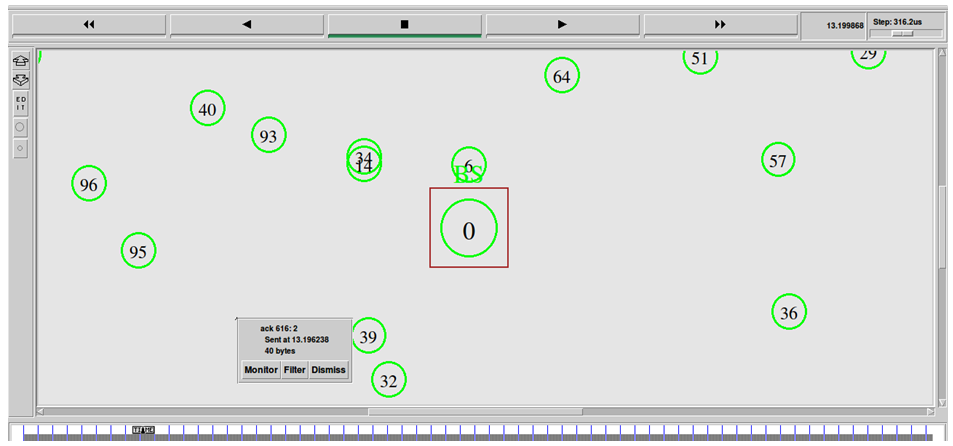 | Figure 8. Generation of Acknowledgement Packet |
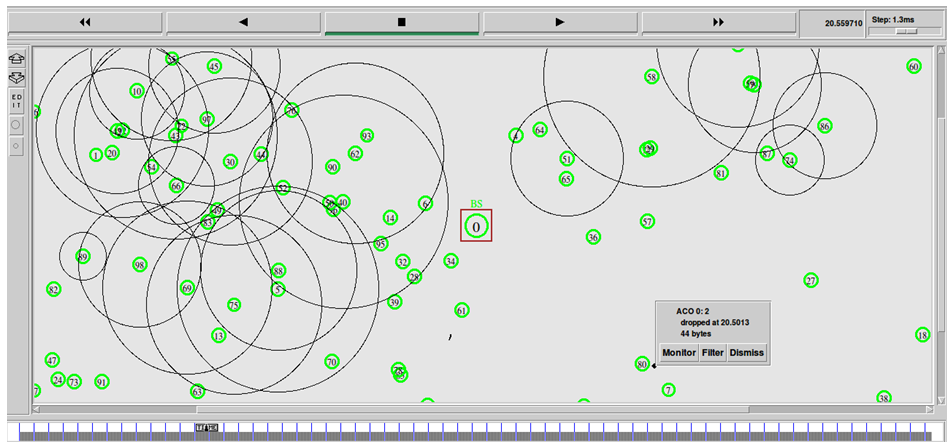 | Figure 9. Control Packet Overhead |
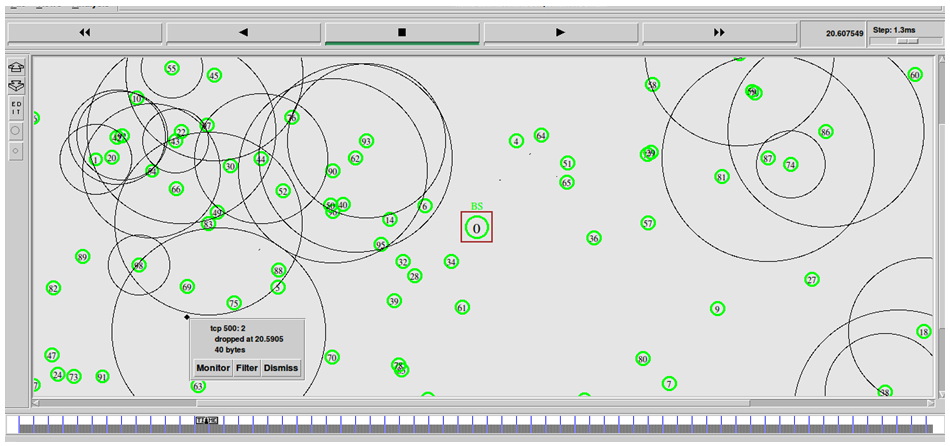 | Figure 10. Handling of Route Failure by Ant Colony Optimization Algorithm |
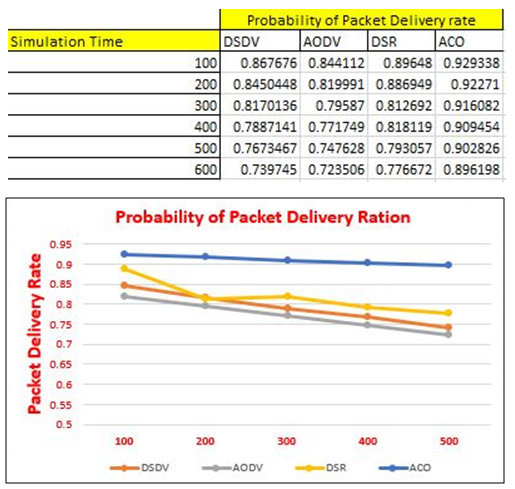 | Figure 11. Performance Comparison of Routing Protocols on basis of Packet Delivery Ratio |
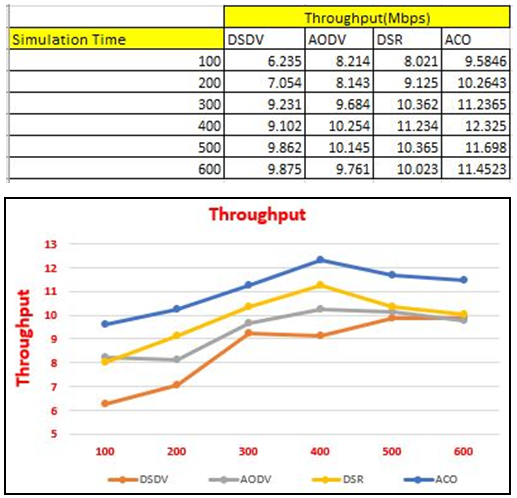 | Figure 12. Performance Comparison of Routing Protocols on basis of Throughput |
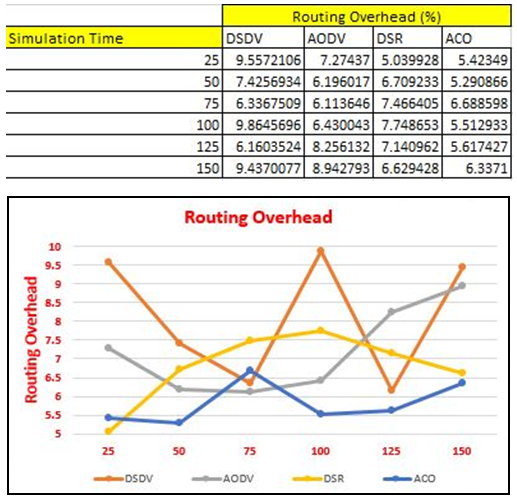 | Figure 13. Performance Comparison of Routing Protocols on basis of Routing Overhead |
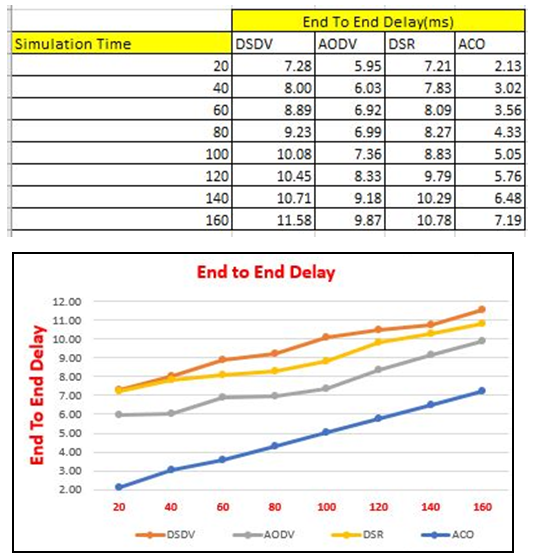 | Figure 14. Performance Comparison of Routing Protocols on basis of End-To-End delay |
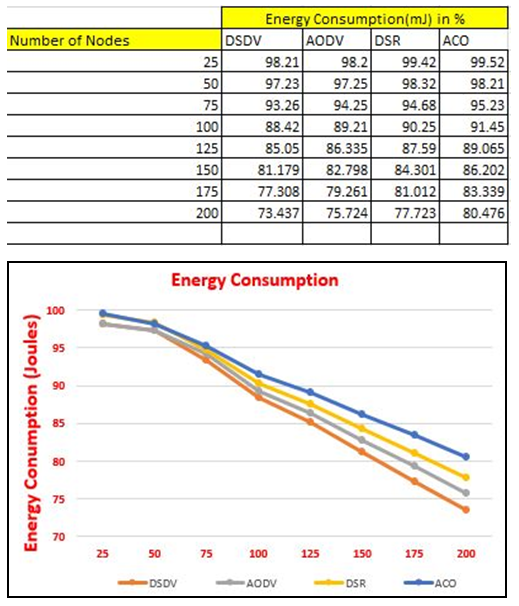 | Figure 15. Performance Comparison of Routing Protocols on basis of Energy Consumption |
6. Conclusions and Future Scope
- Wireless Sensor Networks are regarded as highly dynamic, flexible and special type of networks which are gaining researchers attention in recent times. Wireless Sensor Networks are using multi-path routing instead of static networks infrastructure and are always making use of Dynamic topology in real-world implementations. Therefore, there are always new challenges are shortcomings in routing protocols of WSNs as traditional protocols are not getting replaced by latest protocols based on Swarm Intelligence based techniques like ACO, BEE Colony or PSO. Researchers are designing new protocols and are comparing the protocols with existing protocols in terms of suitability, stability and performance.This research paper is a novel attempt towards comprehensive evaluation of four main protocols- AODV, DSDV, DSR and ACO Based Routing Protocol. In the past few years, new standards are implemented to enhance the performance of sensor nodes operating in WSN environment. In this paper, using the latest simulation environment NS-2.35, we have evaluated performance of four routing protocols on basis of Packet Delivery Rate, Throughput, End to End Delay, Routing Overhead and Energy Efficiency and the Data Values and Graphical Analysis shows that SI based ACO Routing Protocol overrun’s in terms of various parameters and further improves the overall performance of WSN network in real-world environments.In short, ACO Routing Protocol is all round performer as it has low end-to-end delay, less packet overhead, best throughput, less routing overhead and maintains energy efficiency in the network.
Future Scope
- Further, we are working on design and development of our own novel routing protocol based on ACO- Swarm Intelligence Technique and will be best in terms of routing performance, end-to-end delay, packet overhead and throughput.
 Abstract
Abstract Reference
Reference Full-Text PDF
Full-Text PDF Full-text HTML
Full-text HTML